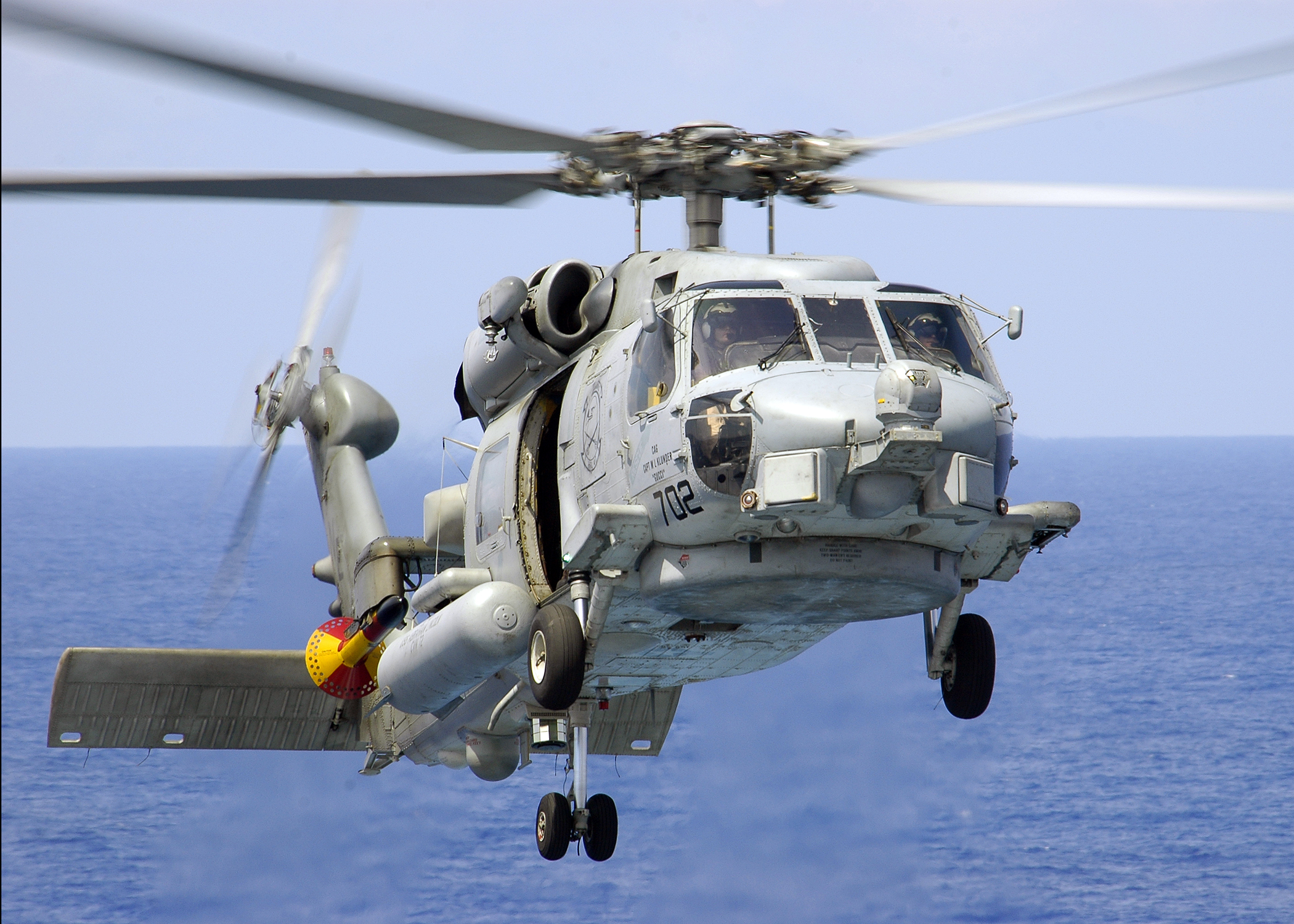
Sikorsky SH-60 Seahawk
The Sikorsky SH-60/MH-60 Seahawk (or Sea Hawk) is a twin turboshaft engine, multi-mission United States Navy helicopter based on the United States Army UH-60 Black Hawk and a member of the Sikorsky S-70 family. The most significant modifications are the folding main rotor blades and a hinged tail to reduce its footprint aboard ships.
"SH-60" redirects here. For other uses, see SH60 (disambiguation).The U.S. Navy uses the H-60 airframe under the model designations SH-60B, SH-60F, HH-60H, MH-60R, and MH-60S. Able to deploy aboard any air-capable frigate, destroyer, cruiser, fast combat support ship, expeditionary transfer dock, amphibious assault ship, littoral combat ship or aircraft carrier, the Seahawk can handle anti-submarine warfare (ASW), anti-surface warfare (ASUW), naval special warfare (NSW) insertion, search and rescue (SAR), combat search and rescue (CSAR), vertical replenishment (VERTREP), and medical evacuation (MEDEVAC).
Design and development[edit]
Origins[edit]
In the 1970s, the U.S. Navy began looking for a new helicopter to replace the Kaman SH-2 Seasprite.[3] The SH-2 Seasprite was used by the Navy as its platform for the Light Airborne Multi-Purpose System (LAMPS) Mark I avionics suite for maritime warfare and a secondary search and rescue capability. Advances in sensor and avionic technology lead to the LAMPS Mk II suite being developed by the Naval Air Development Center. In 1974, the Navy conducted a competition to develop the Lamps MK III concept, which would integrate both the aircraft and shipboard systems. The Navy selected IBM Federal Systems as the Prime systems integrator for the Lamps MK III concept.
Since the SH-2 was not large enough to carry the Navy's required equipment, a new airframe was required. In the mid-1970s, the Army evaluated the Sikorsky YUH-60 and Boeing Vertol YUH-61 for its Utility Tactical Transport Aircraft System (UTTAS) competition.[4] The Navy based its requirements on the Army's UTTAS specification, to decrease costs from commonality as the new airframe to carry the Lamps MK III avionics.[3] In April 1977, Sikorsky and Boeing-Vertol submitted proposals for Navy versions of their Army UTTAS helicopters for review. The Navy also looked at helicopters being produced by Bell, Kaman, Westland and MBB, but these were too small for the mission. In early 1978, the Navy selected Sikorsky's S-70B design,[3] which was designated "SH-60B Seahawk".
SH-60B Seahawk[edit]
IBM was the prime systems integrator for the Lamps MK III with Sikorsky as the airframe manufacturer. The SH-60B maintained 83% commonality with the UH-60A.[5] The main changes were corrosion protection, more powerful T700 engines, single-stage oleo main landing gear, removal of the left side door, adding two weapon pylons, and shifting the tail landing gear 13 feet (3.96 m) forward to reduce the footprint for shipboard landing. Other changes included larger fuel cells, an electric blade folding system, folding horizontal stabilators for storage, and adding a 25-tube pneumatic sonobuoy launcher on the left side.[6]
An emergency flotation system was originally installed in the stub wing fairings of the main landing gear. It was found to be impractical and possibly impeded emergency egress, and was removed. Five YSH-60B Seahawk LAMPS III prototypes were ordered. The first YSH-60B flight occurred on 12 December 1979. The first production SH-60B made its first flight on 11 February 1983. The SH-60B entered operational service in 1984, with its first operational deployment in 1985.[4]
The SH-60B is deployed primarily aboard frigates, destroyers, and cruisers. The primary missions of the SH-60B are surface warfare and anti-submarine warfare. It carries a complex system of sensors, including a towed magnetic anomaly detector (MAD) and air-launched sonobuoys. Other sensors include the APS-124 search radar, ALQ-142 ESM system and optional nose-mounted forward looking infrared (FLIR) turret. Munitions carried include the Mk 46, Mk 50, or Mark 54 Lightweight Torpedo, AGM-114 Hellfire missile, and a single cabin-door-mounted M60D/M240 7.62 mm (0.30 in) machine gun, or GAU-16 .50 in (12.7 mm) machine gun.
A standard crew for a SH-60B is one pilot, one ATO/Co-Pilot (Airborne Tactical Officer), and an enlisted aviation warfare systems operator (sensor operator). The U.S. Navy operated the SH-60B in Helicopter Anti-Submarine Squadron, Light (HSL) squadrons. All HSL squadrons were redesignated Helicopter Maritime Strike (HSM) squadrons, and transitioned to the MH-60R between 2006 and 2015.
The SH-60J is a version of the SH-60B for the Japan Maritime Self-Defense Force with different avionics. The SH-60K is a modified version of the SH-60J. The SH-60J and SH-60K are built under license by Mitsubishi in Japan.[7][8]
Related development
Aircraft of comparable role, configuration, and era
Related lists